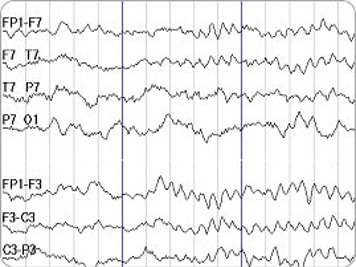Cells in the brain use low levels of electricity to communicate. An electroencephalogram (EEG) is a test that looks at the patterns and location of electrical activity in the brain. During the test, these patterns of electricity are recorded as wavy lines on a computer or on paper. The doctor uses these wavy lines to find out what your child’s problem is. This test usually takes about one hour and does not hurt.

Why is an EEG done?
Doctors use the EEG to see where your child has problems with the electricity made in the brain cells. The wavy lines that the electricity patterns usually make change when there is a problem, such as a seizure. The pattern of wavy lines tells the doctor if there is a seizure, where they come from, and how to best treat the problem.
How can you prepare your child for an EEG?
You should wash your child’s hair before you bring them to the hospital. Please do not use any conditioner or gel on your child’s hair. If your child cannot lie still for the test, they may need a mild sedative. A sedative is a medicine that will calm your child so that they can lie still. Before having any sedation, your child will have to be careful about what they eat or drink. They will need to stop eating and drinking sometime before the sedation is given. The treatment team will tell you when your child needs to stop eating and drinking. Your child may have to wear hospital clothing or a gown during the EEG.
How is the EEG done?
Your child will generally lie comfortably on their back on a bed, although in some cases, EEGs are done with the child seated. To make sure your child keeps still during the test, they may be wrapped in a soft sheet or given a mild sedative.
Your child’s head will be measured and marked with a wax pencil so that the EEG technologist knows where to put the small gold circles called electrodes. The marked areas on your child’s head will be cleaned with a special gel, which is a thick soap. Then electrodes will be stuck on your child’s head with cream and gauze. This will not be painful but it might be uncomfortable if your child has long hair. The electrodes are hooked up to the computer with long wires. Sometimes the electrodes are in a rubber cap like a bathing cap.
The computer records the patterns of electricity of your child’s brain. During the test, the technologist may ask your child to:
- breathe deeply for three minutes
- close their eyes
- watch a flashing bright light for a few minutes
These exercises are done to stimulate certain types of brain activity.
- Your child may have the test while they are asleep and awake. This is done to see the differences in the brain when your child is awake and asleep.
- Throughout the test, the machine makes a continuous record of your child’s brain activity, or brainwaves, on a long strip of recording paper or on a computer screen. This graphic record is called an electroencephalogram.
Are there any side effects?
If your child did not have a sedative, they will have no side effects, or problems, from the EEG. If your child had a sedative, they may be sleepy, grumpy, and unsteady for four to six hours. Please check on your child carefully for about six hours after the test. Give your child only small sips of clear liquids such as water or apple juice. Your child may have a regular meal if they feel like eating. When your child is fully awake, they may return to their usual activities. Your child’s hair may be a little sticky from the cream. You can easily wash out the cream with shampoo.
Magnetoencephalogram (MEG)
A magnetoencehalogram (MEG) measures magnetic fields in the brain. These magnetic fields are caused by the electrical activity of nerve cells in the brain. An MEG is used to map brain function near a tumour or the site of epileptic seizure, or during recovery after brain injury.
The MEG equipment is in a special magnetically-shielded room. The electrodes for the MEG are all contained in a large helmet that looks a bit like the hair dryers in hair styling salons. An MEG study will take about one hour.